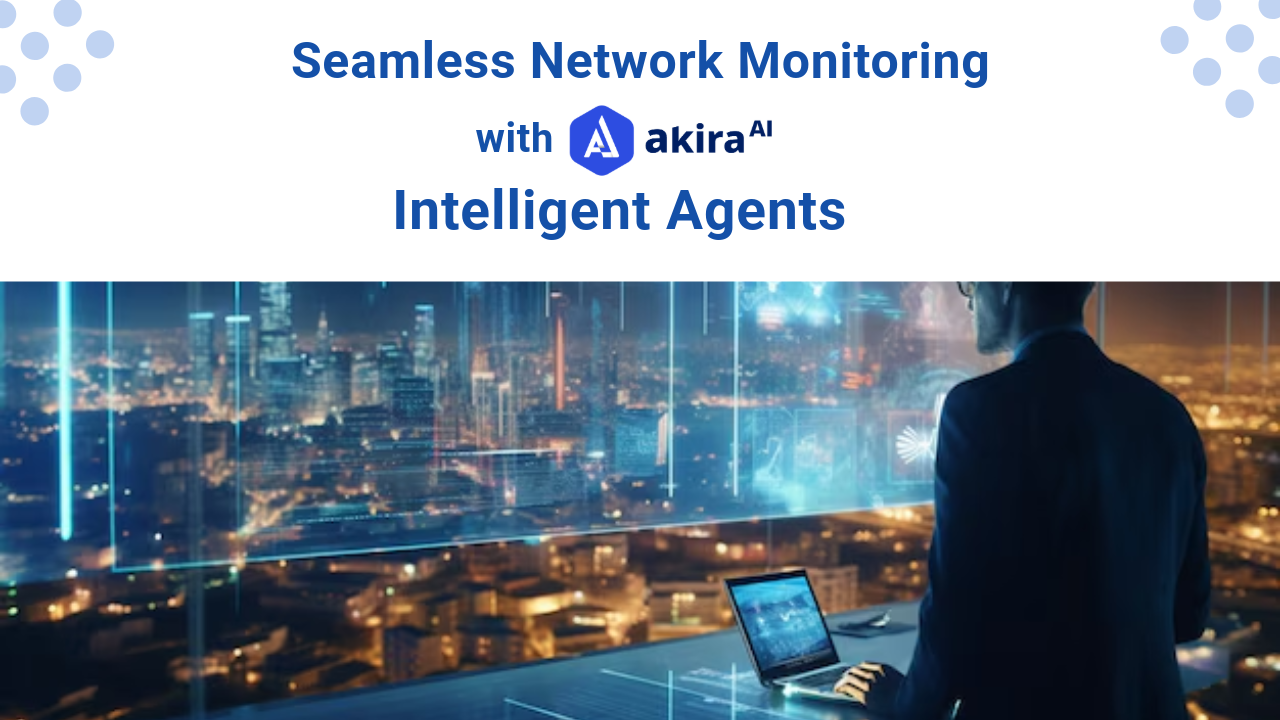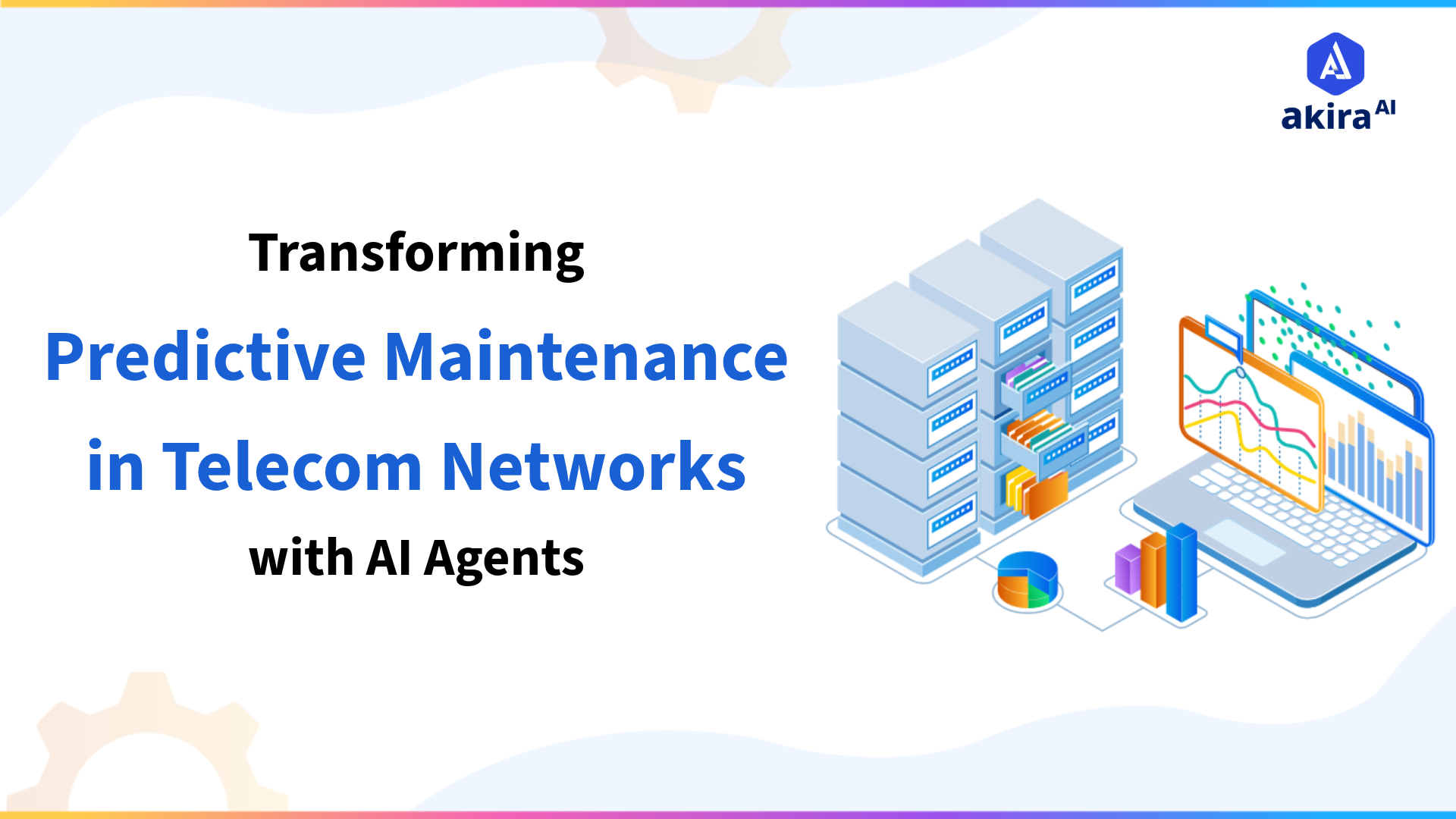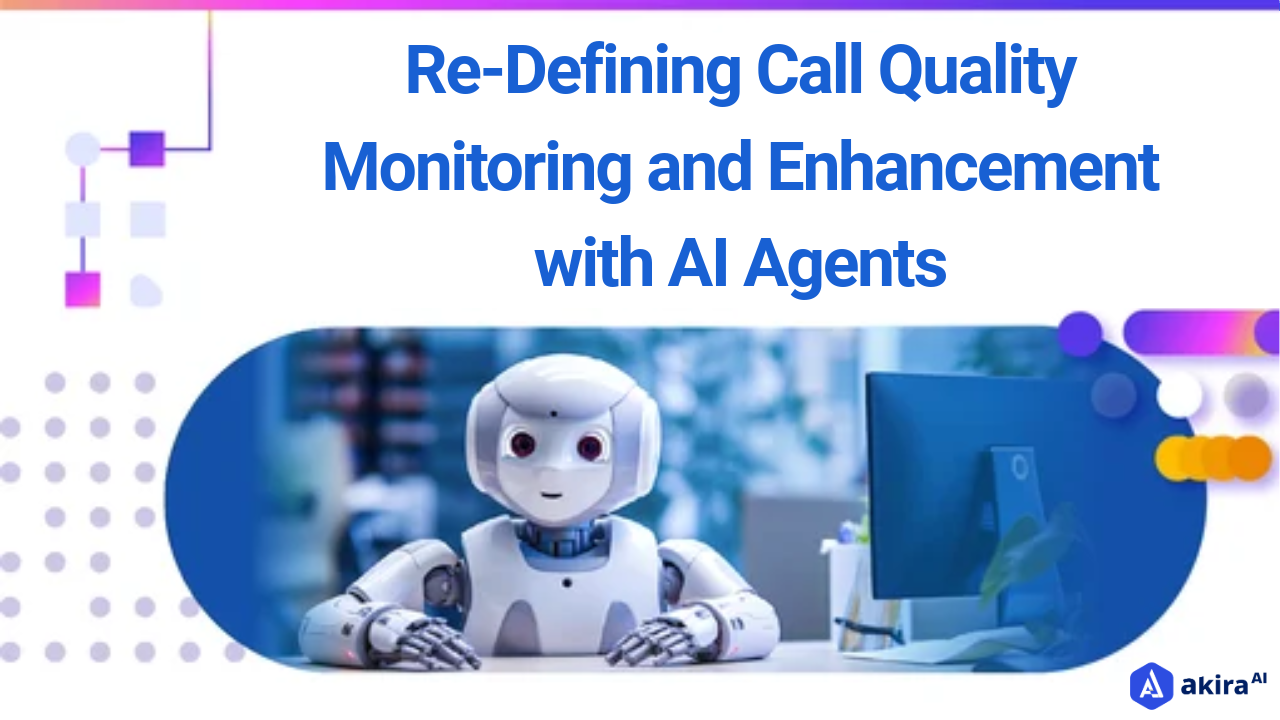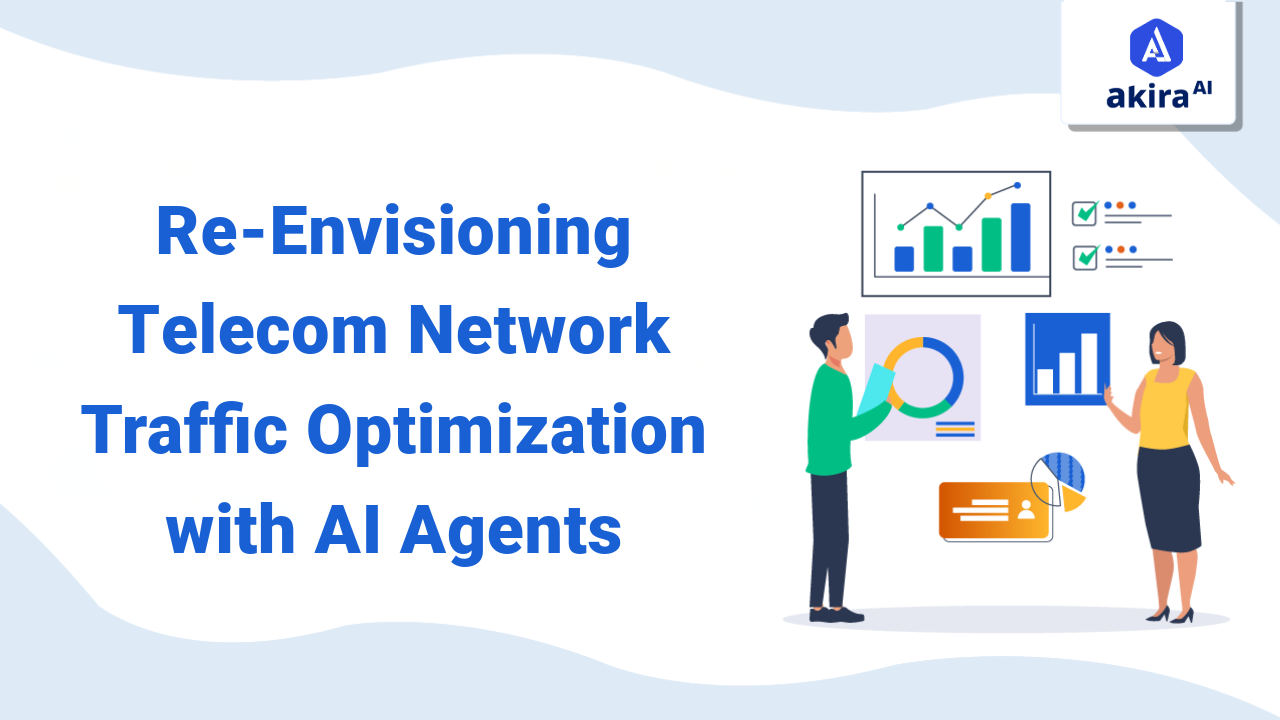Key Insights
At Akira AI, we have developed an advanced network monitoring multi-agent system, integrated within our Composite AI Framework, which combines traditional machine learning with advanced agent-based AI capabilities. Akira AI’s approach delivers more accurate and timely network insights, reducing the need for manual intervention while protecting critical infrastructure with minimal resource expenditure.

In today’s digital environment, businesses are constantly looking for new ways to streamline their network operations, reduce costs, and improve their processes. The impact of generative AI and AI agents is huge, with impacts being felt on business types including network monitoring.
This blog explores how Akira AI’s multi-agent system is transforming network monitoring by providing AI agent-powered solutions that address challenges in this area. Let us take a closer look at how AI agents are shaping the future of network surveillance.
How AI Agents Transform Network Monitoring
AI Agents
AI agents are computer programs designed to perform tasks autonomously by making decisions based on their environment, input, and specific objectives. Unlike traditional automation systems that rigidly follow predefined instructions, AI agents can think, adapt, and act independently. They are equipped to assess their surroundings, learn from previous experiences, and make decisions aimed at achieving particular goals.
AI agents range from simple programs that handle single tasks to sophisticated systems that manage complex processes. They thrive in unpredictable environments, leveraging their learning capabilities to navigate the internet, interact with applications, process vast amounts of data, engage in transactions, and continually refine their methods based on feedback.
AI Agents in Network Monitoring
Networks play a crucial role in business operations. AI agents are utilized to provide ongoing monitoring, ensuring that network performance remains at its best.
AI agents are transforming network monitoring by automating tasks that once required human oversight. These agents continuously monitor network traffic and analyze the data in real-time to identify anomalies and potential. With the ability to manage complex network infrastructure, AI agents can dynamically change processes and optimize performance, ensuring smooth and efficient network operations to network analysts to provide real-time alerts. Their advanced diagnostic capabilities enable them to quickly identify problems, measure the impact of these problems, and provide insights as they can be used for quick maintenance.
Mastering Network Monitoring Challenges with Agentic AI
Traditional monitoring solutions and analysis techniques are being left in the dust by the demands that a modern network environment is being put upon. As the scale and complexity grow, traditional techniques are not going to hold, thereby causing a variety of pretty major issues.
-
Data Overload: Large volumes of information come in from different devices, applications, and users over the networks. These are hard to cope with by the traditional monitoring tools, so there is considerable slowing down of efficiency. Systems may lose critical insight hidden among big datasets and delay threat detection or report inaccuracies.
-
Threat Detection-Slow: Traditional network monitoring solutions have a significant disadvantage with respect to cyber threats: they always rely on outdated signatures and static rule sets. By their very nature, the tools are reactive and detect threats based on predefined patterns of attacks. This results in critical delays in threat detection that leave networks wide open to advanced attacks.
-
Traditional Low False Positives: It is another challenge because they create too many alerts, which drowns the security analyst; he must comb through millions of notifications for actual threats.
-
Analyst Fatigue: The constant stream of notifications, requiring manual analysis, puts a heavy burden on security teams. Often, analysts are forced to work long hours under high stress, which results in burnout and losses in effectiveness.
-
Delayed Response and Missed Threats: This in turn lowers threat detection and with it increases the rate of positives coupled with analyst operational fatigue, which eventually leads to missed threats and delays in reaction. The results cascade over time, and indeed, actual slipping through of a threat can have massive effects.
-
Cost of Network Downtime: Bad network monitoring leads to massive downtimes of systems and services which has a financial impact on the industry.
Addressing the challenges via AI Agents
AI agents help to solve this problem by analyzing network logs and conducting much data processing instantly, so as not to let critical information get lost in the sea of data. In other words, it makes for quicker and more accurate threat identification in comparison to the older platforms. AI-powered agents also minimize the number of false positives, allowing the security analyst to work on real threats rather than get swamped with irrelevant alerts. AI agents carry out routine activities while detecting threats at a much-improved state, therefore reducing analyst fatigue. It opens up room for actions to be taken faster in the event of probable threats, reduces the chances of incurring expensive network downtime, and makes networks reliable.
Unveiling Akira AI’s Multi-Agent Network Monitoring Revolution
Akira AI’s network monitoring agentic workflow revolutionizes network monitoring by automating every aspect of the observability cycle. The system is composed of an agentic workflow with several specialized AI agents, each designed to handle a specific task within the network process.
.png?width=1921&height=1081&name=image%20(14).png) Figure: Technical Architecture of Autonomous Agents for Network Monitoring
Figure: Technical Architecture of Autonomous Agents for Network Monitoring
Process Flow
The Multi-Agent System of Akira AI was formed by specialty agents who will be assigned specific roles in managing the network. Their cooperation is surely warranted for faster processing with high accuracy in decision-making, added to the more efficient and more reliable network management.
-
Role-Defined Individual Agents: In MAS, every agent performs a particular specialized duty; be it data analysis systems management, or anything else. Hence, assigning the role of agents performing a particular task allows different agents to work much more effectively and also ensures that every aspect of the network is well looked after.
-
Knowledge graphs: This will be the decision-making adoption of knowledge graph intelligence, mapping the relationship between different elements in network T showing their relations. Here, therefore, relations are supposed to be used in making these insights and decisions taken by the agents accurate and rational for the stabilization and security of the network.
-
Real-time processing and decision-making: The MAS of Akira AI can promptly process data and make decisions. It always watches network activity and changes whenever needed. This real-time ability assures any potential problems can be fixed immediately, thus reducing downtime and assisting in bettering performance over networks.
Technological Backbone of Akira AI's Framework
Our composite AI framework utilizes the components from traditional Machine learning to advance Multi-agent systems:
-
Data Aggregation & Source: We use industry-leading tools like ELK Stack (Elasticsearch, Logstash, Kibana), SIEM solutions such as Splunk or IBM QRadar, and MDM/Firewall systems like Cisco Meraki or Palo Alto Networks to manage and aggregate data.
-
Agent Development & RAG: Advanced agent frameworks like Langchain, Langraph, and AutoGen are used for agent development. Retrieval Augmented Generation (RAG) pipelines are built using Langchain, LlamaIndex, and knowledge graphs for enhanced data retrieval.
-
Orchestration Layer: The system leverages agent orchestrators like AutoGen and LangGraph for complex interactions, while guardrails (such as Azure OpenAI Content Filter) ensure safe and secure AI behavior.
-
Data Pipeline & Backend: We utilize PostgreSQL for structured data, Qdrant for vector data, and secure, scalable backend pipelines to deliver APIs built with best practices.
-
Infrastructure & Frontend: A robust infrastructure setup with on-premises, cloud, or hybrid solutions, combined with user-friendly frontend interfaces, ensures seamless, secure, and efficient operations.
The Multi-Agent System in Action
-
Centralized Data Integration
All types of network logs—including server logs, Security Information and Event Management (SIEM) logs, and other essential data—are consolidated into a unified real-time data storage framework. This aggregated data is housed within a diverse storage architecture, which includes:
-
Vector Database
-
Knowledge Graph
-
Structured Database
-
Real-time Data Storage
2. Agent Data
This information is, first and foremost, collected within the multi-agent system Akira AI by the Data Agent module of data collection, which further is supposed to collect, process, and structure relevant information from databases for further processing. For conducting these activities, it employs the advanced mechanism of interaction with databases and processes large volumes of information that come in natural language format through Large Language Models. It can process both historical and streaming data inputs for ensuring consistency of data and finding inconsistencies/anomalies.
3. Network Analyzer
Once data is collected, the network analyzer agent comes into play which assesses the criticality of network events and suggests next steps based on domain-specific knowledge. The agent utilizes a Large Language Model specifically trained in network security and operations. It is responsible for identifying known attack signatures, anomalous behavior, and potential security threats and evaluates the potential impact and urgency of detected events.
4. RCA-Agents Root cause Analysis
An RCA agent follows through with detailed root cause analysis and recommendations on identified issues. It performs comprehensive knowledge retrieval combined with AI-driven insights for desirable results. The latest algorithms are also used in the identification of cause relationships in complex network scenarios. Based on the findings, the agent will create step-by-step action plans from its analysis of the identified root causes. Finally, it develops actionable insights that will be presented to the Network Administrator through the interface of Guardrails
5. Final processing
The outputs of all these specialized agents are then integrated into actionable intelligence within this multiagent network. The agentic system, after receiving input data, advises for the rectification of network issues or improving its performance. After the output is formatted to the detailed findings and is coupled with actionable intelligence, the output regarding the decisions made for the network administrator is presented as an interface.
The system updates the Storage Layer, containing Vector DB, Structural Database, and Knowledge Graph, for storing newly processed information for further reference. In this way, the raw data and outputs of the agents are turned into actionable knowledge for effective network management.
Agentic Workflow by Akira AI vs. Traditional Approaches
|
Feature |
Traditional Monitoring |
Akira AI’s Multi-Agent System |
|
Real-Time Analysis |
Relies on manual checks and periodic updates, often resulting in delayed responses to issues. |
Continuously monitors the network in real-time, providing instant analysis and faster issue resolution. |
|
Predictive Capabilities |
Lacks predictive capabilities, addressing problems only after they occur. |
Utilizes AI to predict potential network issues before they escalate, ensuring proactive management. |
|
Automation of Tasks |
Automation is limited to basic tasks, requiring significant human intervention for complex scenarios. |
Automates a wide range of tasks, from routine monitoring to complex configuration management, reducing the need for manual oversight. |
|
Compliance Management |
Compliance tasks are handled manually, increasing the risk of errors and non-compliance. |
Automates compliance management, ensuring that network operations consistently meet regulatory standards. |
|
Scalability |
Struggles with scaling, especially in large or rapidly growing networks. |
Easily scales to accommodate networks of any size, adapting to changing demands without performance degradation. |
|
Proactive Problem-Solving |
Reacts to issues after they arise, often leading to prolonged downtimes and user frustration. |
Proactively identifies and resolves potential problems, minimizing downtime and improving user experience. |
|
Handling Data Overload |
Suffers from data overload, making it difficult to extract actionable insights in a timely manner. |
Efficiently processes large volumes of data, ensuring that critical insights are not missed and are acted upon promptly. |
Seamless Integration with Existing Systems
1.SIEM and IDS Compatibility: A Perfect Match
Akira AI’s multi-agent system integrates seamlessly with existing Security Information and Event Management (SIEM) and Intrusion Detection System (IDS) tools, enhancing their capabilities and providing a more comprehensive monitoring solution.
2. API Integration: Bridging Systems
The system’s API integration allows it to work with various network management tools like Cisco’s Meraki ensuring that all components of the network are monitored and managed cohesively.
3. Workflows: Further to your needs.
The solution from Akira AI is very customizable, which enables an organization to configure the multi-agent system for its specific needs in monitoring networks.
Key Benefits of AI Agent-based Network Monitoring
-
Better Accuracy and Integration of Data: AI agents go through and analyze large chunks of data precisely and in real time, which makes network monitoring accurate and efficient.
-
Drive Efficiency: By conducting regular monitoring processes, AI agents unburden IT staff and free them to work on strategic initiatives that drive general efficiencies in the management of the network.
-
Ensuring compliance: AI-powered monitoring systems add to this security by ensuring everybody on the network is completely protected from industry-mandated security regulations in an effort to protect systems from potential fines and breaches.
-
Predictive Problem-Solving: AI agents go way beyond traditional monitoring systems because they are problem 'predictors' instead of being mere 'observers'. The agents are, therefore, helpful in bringing down downtime through the identification of early potential threats by finding inefficiency.
-
Scalability and adaptability: The AI agent-based monitoring system will scale the network very comfortably. Even though the AI agents might adapt to do quite massive work, no performance impact would be traced.
Conclusion: AI Agent for Network Monitoring
Also, with increasing volumes and complexity of network issues and security threats, there has never been a greater need for an enterprise-class, efficient network monitoring solution. Agentic AI System by Akira AI makes a quantum leap into the world of autonomous network monitoring by offering unparalleled efficiency, accuracy, and proactive threat remediation. Our solution enables network operations teams to stand up to modern-day network management challenges with total confidence in the security and stability of their digital infrastructure.


